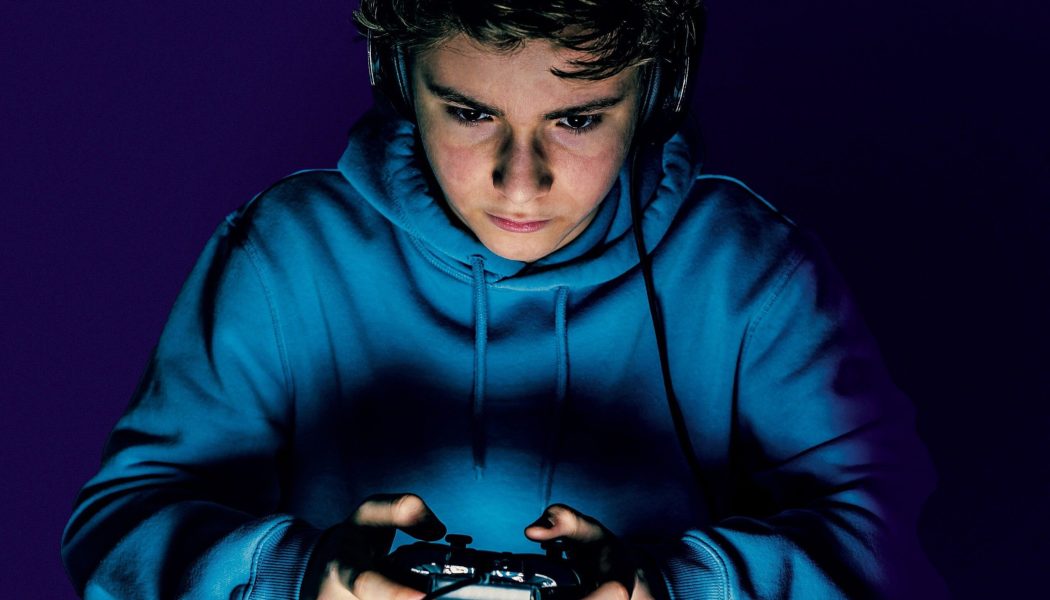Cody was seven years old when he decided what he wanted to do with his life. It was the summer of 2018, and he was watching the World Cup with his parents and younger brother at home on Vancouver Island. When he grew up, he told them, he wanted to play pro soccer.
Plenty of kids dream of becoming soccer stars but, in Cody’s case, the idea wasn’t entirely far-fetched. He was the best player on his local team, and he soon began training with the Vancouver Whitecaps’ youth academy, a pipeline to the pro leagues. He was effortlessly athletic—he earned his black belt in tae kwon do at age eight—and he was in the gifted program at school. Cody, whose name I changed to protect his privacy, had been diagnosed with ADHD, and his parents had detected other signs of neurodivergence: he organized his bathroom countertop fastidiously and couldn’t fall asleep unless his blanket was folded to his liking. But to his teachers and coaches, Cody presented as bright, mature and polite. “He was on a path to do so much more,” his mother, Alana, told me.
Then the pandemic hit. Soccer ceased. School and martial arts shifted online. Instead of bouncing between practices and classes, Cody was suddenly trapped at home. To combat his boredom, he played Xbox. One of his favourite video games was Fortnite, a multiplayer shooter that’s available on pretty much every gaming console, computer, tablet or smartphone. He was partial to the “battle royale” mode, in which he had to outlast up to 99 other players in a Hunger Games–style fight to the death.
Cody’s parents were uneasy with Fortnite’s violence—he was only nine, and the game was rated 13-plus—but its cartoonishness allayed their worries. The game looked less like a battlefield and more like a Pixar-produced acid trip. At the beginning of every round, Cody—or, more precisely, his avatar, a buff combatant wielding a comically oversized pickaxe—boarded a flying blue school bus. Then he’d skydive onto a vast, vibrant island dotted with whimsically named landmarks like Tomato Town and Wailing Woods.
Cody loved the thrill of reaching the final stages of a battle royale, when toxic storm clouds encroached on the island and squeezed him closer to his remaining enemies. In the corner of his screen, a ticker counted how many players stood between him and victory: 25, then 10, and eventually just one. If he managed to blast his last opponent into oblivion, a giant banner flashed across his screen, proclaiming “#1 Victory Royale.” It was exhilarating—not just a Band-Aid for his boredom, but a cure.
Alana allowed Cody to play Fortnite for two hours at a time, a few nights a week. When he was gaming, he wouldn’t eat, drink water or even go to the bathroom. If he lost a round, he’d yell and slam his controller on the ground. When Alana would tell him his time was up, he’d beg to continue. “He was miserable when he couldn’t game,” she says. “That’s all he wanted to do.”
SIGN UP TO READ THE BEST OF MACLEAN’S:
Get our top stories sent directly to your inbox twice a week
Cody’s parents weren’t gamers. Alana hardly even used social media. As a nature-loving horticulturist, she always imagined her sons would spend their childhoods romping around the family’s forested 18-acre property, not cooped up in front of a TV. But during COVID, video games were one of the few ways her son could connect with his friends. They’d call the house, asking if Cody could come online to play. “Gaming became such a part of his social circle that it felt like we’d be depriving him if we said no,” says Alana. So she reluctantly allowed it, making sure he offset his screen time with bike rides and walks along the river. For a while at least, they achieved a healthy balance.
In September of 2021, Cody resumed in-person classes at a new school, but his mind was stuck online. To make friends, he asked his classmates what video games they played. After his second day of school, he came home and excitedly told his mom that he and another student had agreed to game together that night. Alana refused to let him log on. “It’s not a gaming night,” she explained. Cody whined and pleaded, but she held firm. He started to cry, and then came the screaming. Alana begged him to calm down, but he shrieked for five straight hours. She had to shut the windows so the neighbours wouldn’t hear.
That evening was the start of a long nightmare. Whenever Alana forbade Cody from gaming, he had panic attacks, wailing and weeping. He writhed on the floor and told his parents he wanted to die. “It was like taking heroin away from an addict,” says Alana. Sometimes she thought, maybe today it will be different, and so she let him play. But the behaviour never changed. “We felt like his drug dealers.”
Cody’s gaming obsession ruined Christmas, then New Year’s. He fell behind on schoolwork and looked dazed on the soccer field. “He was pretty much a zombie,” says Alana. “He had no motivation to do anything else.” He tried out for a rep team but didn’t make the cut. Fine, he decided. He didn’t want to be a soccer player anymore anyway. He wanted to be a pro gamer, streaming on Twitch and uploading videos to YouTube. (The 16-year-old victor of the 2019 Fortnite World Cup won US$3 million, not much less than Rafael Nadal won at the U.S. Open in the same stadium weeks later.)
Alana didn’t want Cody to become the Gretzky of gaming. She just wanted her son back. She tried to limit his playtime, but nothing worked. When she took away his Xbox, he played on another device. When she hid the power cords, he found them. She tried using an app to restrict his internet access, but he stole her phone and turned the Wi-Fi back on. At wit’s end, she sent Cody outside to play with his brother, locking the door behind them. In a fury, he smashed the door’s window trying to get back in. It cost $2,000 to replace. Alana banned him from gaming for a month after that, but he eventually came crawling back to the controller. “As parents, we were like, ‘We’re really failing him,’ ” says Alana. Her smart, smiling, soccer-loving son was gone, and she had no idea what to do. “It was horrible,” she says. “We lost our kid to gaming.”
Cody isn’t the only kid addicted to Fortnite, and Fortnite isn’t the only game ensnaring children. Parents are losing their sons and daughters to Minecraft and League of Legends, to Roblox and Rocket League. For some families, the problem isn’t video games but smartphones and social media. Three-quarters of Canadian youth own a smartphone, and a 2022 study found that nearly half of those young people worry they spend too much time online.
Childhood is changing. The quintessential touchpoints of adolescence—building Lego and climbing trees, going to the movies and breaking curfew—are being replaced by a new slate of compulsive, screen-based activities: playing video games, binging YouTube videos and mindlessly swiping through 15-second TikToks for hours on end. Parents who are none too pleased with this shift are wondering who they can hold accountable. To them, there is no target so ripe as the tech giants and video game makers who have made billions by co-opting their kids’ lives.
***
To some degree, Cody’s story confirms those age-old knocks on video games: that they’re a waste of time and money, an unproductive hobby with no real-world payoff, a brain-numbing activity that keeps pimply teenagers stuck to their screens while their grades nosedive and their muscles atrophy. But there’s so much more to gaming than Cheeto-fingered escapism. Take it from me. I’ve been gaming longer than Cody’s been alive.
As a kid, I played and replayed classic Nintendo 64 titles: Super Mario, GoldenEye, Star Fox. Some nights, after my parents had gone to bed, my older brother and I would sneak downstairs and play GameCube until our eyelids drooped shut. In my teens and 20s, I occasionally spent showerless Saturdays in front of my TV, Xbox controller in one hand, slice of Domino’s in the other. The Christmas break before I met my wife—who would never have tolerated such a thing—I played The Legend of Zelda for a week straight as if it were my full-time job. Was it healthy? Nope. Did I love it? Absolutely.
Whenever Alana forbade Cody from gaming, he had a panic attack. He writhed on the floor and told his parents he wanted to die. “It was like taking heroin away from an addict,” Alana says.
Some of my go-to games provided nothing more than cheap thrills. I wasted hundreds of hours on Diablo, a game in which I had to descend into the depths of hell to defeat the devil, because I couldn’t resist the draw of finding new, ever-rarer weapons and armour. I replayed Resident Evil 4 a dozen times because there’s something endlessly satisfying about blowing up a zombie’s head. But my favourite games were the ones that offered something my real life lacked. I’ve never landed a kickflip, but in Tony Hawk’s Pro Skater, I was a master of the half-pipe. Exploring the fantasy world of Skyrim, I wasn’t just some kid in the suburbs of Toronto; I was a noble swordsman on an epic quest to save the realm. In a video game, even a loner can feel like a king.
For me, and for millions of gamers like me, video games are a mild vice at worst. Enjoyed in moderation, they can be a benign, even constructive, pastime. Gaming develops hand-eye coordination, visual-spatial processing and leadership skills. Co-operative games teach kids how to work in teams, and health-care educators use games to train doctors and nurses. I’ve played games that have sparked my curiosity, challenged my problem-solving skills, tested my morality and even moved me to tears. Games have even provided a backdrop to some of my deepest, most therapeutic conversations. Once, after a particularly bad breakup, my closest pals came over and let me bare my soul as we fended off hordes of the undead together.
I tried Fortnite when it first came out—practically every gamer did. It was unlike anything I’d played before. It combined the high-octane combat of Gears of War, the scavenger-hunt satisfaction of Diablo and the world-building mechanics of Minecraft. Still, I stuck with Fortnite for only a few weeks. I wish I could tell you I quit because I was impervious to its appeal, but the truth is that I simply defected to a different battle royale–style game: Call of Duty: Warzone. (It’s essentially Fortnite by another name.) I still remember the first (and only) time I won a round of Warzone. Adrenaline rushed through my body. My heart raced and my breath quickened. When I got that final kill, I leapt from my couch and whooped with joy. It didn’t matter that, in the real world, my victory didn’t matter. The high was intoxicating.
I never got addicted to Warzone, but it was easy to see how someone might. The human brain rewards pleasurable and arousing activities—for example, eating chocolate or smoking cigarettes—by releasing dopamine. A study published in Nature showed that gaming can more than double a player’s baseline dopamine levels, resulting in the sort of elation I felt when I won a round of Warzone. Stanford neuroscientist Andrew Huberman claims that, for some players, gaming can increase dopamine levels as much as having sex or snorting cocaine. Our brains are programmed to seek out more of these hits, which is what drives gamers to keep gaming. People with ADHD and autism spectrum disorder—kids like Cody—have abnormal dopamine receptors. For them, games like Fortnite act as a firehose of feel-good chemicals.
The trouble is that the euphoric feelings don’t last. Gamers develop tolerances. They need to play more to achieve the same rush. After overloading their brains with happy signals, an equal and opposite reaction occurs. Their baseline dopamine level drops. They get angry, sad and apathetic. When they lose a round or their parents kick them off their consoles, they throw their controllers, enter withdrawal-like hazes and lose the drive to do just about anything else.
SUBSCRIBE NOW: Get the magazine in your mailbox each month
Since the dawn of Pong, psychiatrists have been debating whether or not to treat excessive gaming as an addiction. In 2018, the World Health Organization recognized “internet gaming disorder.” People with IGD play video games pathologically, continuing long after their habits have negatively affected their physical and mental health and their professional lives. Estimates suggest that up to 60 million people have this condition. It doesn’t help matters that games are cheaper, more advanced and more accessible than ever before, says Jeffrey Derevensky, a McGill University psychology professor who sat on the advisory panel that helped the WHO identify the disorder. “Kids are walking around with a mini-console in their pockets,” he says. “Gaming is a hidden addiction. You can’t smell it on their breath and you can’t see it in their eyes. And so parents are often totally unaware of what their children are doing.”
In theory, any game can suck anyone in. For this story, I spoke to gamers of all ages who’d been addicted to real-time strategy titles and virtual pirate adventures, mobile games and first-person shooters. But modern video games—Fortnite, Warzone and their ilk—are especially seductive, stuffed with features that prey on the brain’s desire for dopamine. This evolution has gone largely unchecked. Even as industry giants have rolled out increasingly addictive games, they’ve maintained that their products are innocent fun. Governments seem to have taken their word for it. Most countries have yet to specifically regulate video games or their makers. That leaves players and parents to fend for themselves—and some of them are starting to fight back.
***
Earlier this year, Alana’s friend sent her a news article. In B.C. and Quebec, it reported, a handful of children had stopped eating, sleeping and showering to play battle royale on Fortnite. Over the course of two years, one boy had played it for nearly 1,000 hours—the equivalent of almost 42 days—and started suffering from gaming-related migraines, back pain and panic attacks. Like Cody, the kids threw fits when their parents tried to intervene. Unsure what to do, the families had banded together to launch a pair of class-action lawsuits against Fortnite’s developer, Epic Games, alleging that the company had intentionally designed the game to be addictive.
That in itself isn’t illegal—coffee is addictive, yet no one’s suing Starbucks over it. But the cases also claim that Epic broke product liability laws, which hold that manufacturers should be held responsible for their products’ unexpected dangers or defects. If a driver gets injured because their airbag malfunctions, liability laws are what allow them to sue the company that made it. They’re also what convinced the Quebec courts to order cigarette makers to pay $15 billion to smokers in 2015.
Historically, liability laws have applied mostly to physical products. But lately, lawyers have been applying liability theories to technology, too. Late last year, a group of parents sued Amazon for selling toxic chemicals that their teenage children used to kill themselves. (Amazon denies liability, saying the substance, like many products, can be misused.) Another case concerned an Uber driver who hit and killed a six-year-old girl because he was looking for fares on his phone while driving. (Uber argued it was not liable and settled out of court.)
Courts and legislators are now using liability laws to rein in big tech. The U.S. Supreme Court is currently weighing whether YouTube, Facebook and Twitter can be sued because their algorithms allegedly led users to content that promoted acts of violent extremism. Last year, the European Union began updating its liability rules to make it easier for people harmed by artificial intelligence to receive compensation. Self-driving cars aren’t supposed to crash, but when they inevitably do, there will no doubt be a litany of liability suits to sort out.
Gamers and their parents have used liability laws against video game developers before. After the mass shooting at Columbine High School in 1999, grieving parents sued several game studios, alleging their games influenced the shooters’ actions. (That case was dismissed; research shows there’s no evidence that violent video games encourage real-world violence.) The Canadian class actions against Epic are novel because they allege a different sort of affliction: an addiction to a video game. The suits argue that the company knew, or ought to have known, that Fortnite could cause players harm, such as IGD. And because Epic failed to warn players about those dangers, the suit says it should be liable for the damage it caused.
Epic, of course, sees things differently. “Fortnite was designed to be a fun and easy-to-use experience,” Candela Montero, Epic’s senior director of public policy, wrote me in an email. “We will fight these baseless allegations.” (The claims have not been proven in court.) The company tried to get the first of the two class actions dismissed, but in December of 2022, a Quebec judge certified the suit. The decision signalled that, if Canadian governments and regulators weren’t going to crack down on video game developers—and, by extension, other big tech creators—the justice system might. CaLex, the Montreal law firm representing the Quebec plaintiffs, is now selecting expert witnesses, finding more members and preparing for trial. Jean-Philippe Caron, the lawyer leading the case, told me that he’s heard from some 500 families across Canada who are interested in joining. The original case is only open to Quebecers, but, earlier this year, the firm teamed up with a B.C.-based law firm to launch another class action that, if certified, will allow families elsewhere in the country to participate. It may be years before either suit reaches trial, but if they do get that far, these families will be in for the fight of their lives.
A boy in South Carolina kept playing Fortnite even as a tornado ripped through his town. An eight-year-old in Tennessee went to the ER with a bladder problem because he refused to stop playing.
Epic is a gaming Goliath, with more than 50 offices and thousands of employees. That includes a lot of well-paid lawyers. The company is worth about $43 billion and has two major owners: the $600-billion Chinese conglomerate Tencent and Tim Sweeney, the code-writing, Lambo-collecting geek who founded Epic 32 years ago under the slightly less sexy name Potomac Computer Systems.
Sweeney is no stranger to spending long, lonely days in front of a screen. At age nine, he taught himself to code. In the early 1990s, he built his first game in his parents’ basement. It was a lo-fi puzzler called ZZT, where players controlled a smiley face that fought pixelated creatures. Players could build their own levels, which opened the door to limitless customization and playability. ZZT was a surprise hit. Sweeney enlisted his dad to help him mail CD-ROMs to customers to keep up with demand.
In his 20s, Sweeney parlayed his early success into a full-blown gaming business. He hired staff, coded more titles and kept his eye on the nascent industry. In the mid-’90s, the biggest game in the world was Doom, a 3D shooter with then-revolutionary graphics, lightning-paced play and a heavy metal soundtrack. Inspired by Doom’s success, Sweeney built his own shooter, Unreal. The game was good—it sold 1.5 million copies in its first four years—but its true legacy was the platform on which it was built: the Unreal Engine. The engine was like a starter kit for wannabe game makers. Its powerful, user-friendly interface allowed developers to design levels, create characters and dictate in-game mechanics without an in-depth understanding of the underlying code. Epic licensed the Unreal Engine to other developers, who could use it to build games, sometimes in exchange for royalties. The arrangement was like selling pickaxes during the gold rush. As gaming boomed in the 2000s, studios across the world used the Unreal Engine to create blockbuster series like Final Fantasy, Mass Effect and Borderlands. Even TV shows like The Mandalorian and Westworld have leaned on the Unreal Engine to create fantastical on-screen universes.
By his 30s, Sweeney was a millionaire many times over. He bought a fleet of sports cars and took MTV on a tour of his sprawling new mansion. He showed them a dining table he’d never used and a piano he couldn’t play. “I don’t know why I have a big house,” he mumbled uncomfortably to the camera. “I don’t really need it. I don’t use much of the space. I figured, I have the money. Why not?” An Epic employee told MTV that Sweeney could have easily bought an island in Fiji and retired. Instead, he chose to keep doing what he’d always done: spend 14 hours a day in front of a computer, coding. “This is just Tim’s life, being here and working on the technology,” the staffer said. After all, Epic needed him. The company had a big new project in the works.
When Epic began developing Fortnite in 2011, the company envisioned it as a co-operative, teen-friendly adventure in which players would work together to save the world from zombies. But in March of 2017, just before Fortnite was finished, a Korean studio named Bluehole released PlayerUnknown’s Battlegrounds. The game—built, as it happens, on the Unreal Engine—took inspiration from the Japanese thriller Battle Royale, pitting 100 players against one another on an island. PUBG was, for a time, the most popular game in the world. Tens of millions of gamers bought it. Epic was eager to emulate its success, and the team added a battle royale mode to Fortnite.
Fortnite is now the most-played video game of all time. One survey found that 60 per cent of teen participants had tried it. It has roughly 500 million registered users. Fortnite’s cultural footprint now extends well beyond the world of gaming. The rapper Travis Scott and the EDM DJ Marshmello have both played concerts inside the game. Epic has partnered with Disney and Netflix, the Olympics and the NBA, Lego and Monopoly, which means you can play Fortnite as Darth Vader, Michael Jordan, John Wick, Ariana Grande or a Ghostbuster. The game makes a cameo in Avengers: Endgame, and every Avenger appears in the game. The Marvel Cinematic Universe, it seems, is really just a tiny piece of the much larger Fortnite Universe. With every brand crossover, Fortnite becomes more like the bagel from Everything Everywhere All at Once, determined to suck up all the IP in the universe and stuff it into one never-ending entity.
For some players, it’s too enticing to resist. A boy in South Carolina kept playing Fortnite even as a tornado ripped through his town. An eight-year-old in Tennessee went to the ER with a bladder problem because he refused to stop playing long enough to go to the washroom. It’s not just kids. Several pro sports teams, including the Toronto Blue Jays and Vancouver Canucks, have restricted their rosters’ Fortnite-playing privileges, concerned that excessive gaming was throwing players off their game. In the U.K., a divorce-services website reported that couples had begun citing Fortnite as the primary reason for their split. Speaking at a mental health conference, Prince Harry called for the game to be banned. “It’s created to addict,” he said, “an addiction to keep you in front of a computer for as long as possible.” Two months after Harry made those comments, Epic Games participated in an inquiry into addictive technologies at the U.K.’s House of Commons. One MP suggested the game was designed to make money off of its players. “I would disagree,” Epic’s general counsel said. “The battle royale mode is free to play.”
***

(Photo illustration by Lauren Cattermole; photograph by iStock)
Fortnite is indeed free to play, but it never stops reminding players of all the ways they can feed the game their cash. Between every round of battle royale, gamers have a chance to purchase “skins,” a catch-all term for clothes and customizations that change the appearance of a player’s characters, weapons and vehicles. There are thousands of these accoutrements available for purchase in the Fortnite shop for $5 to $15 apiece: backpacks that players’ avatars can wear, dance moves they can bust out, giant flaming assault rifles they can wield. For $10, players can buy a “battle pass,” a 10-week subscription that grants them access to even more skins. These nickel-and-dime purchases are called micro-transactions, and they can add up. One of the children represented in the Quebec class action spent $6,000 on skins, draining a bank account that was meant to help pay for university.
In 2020, the Federal Trade Commission began investigating the company’s alleged use of dark patterns and collection of kids’ personal information. When Fortnite debuted in 2017, the FTC alleged, it employed deceptive digital tricks known as “dark patterns” that made it easy for players to buy skins and exceedingly difficult for them to get their money back. Back then, if a father were to enter his credit card information to buy his Fortnite-playing son a Batman skin, for example, the game would automatically save those payment details, allowing the boy to keep shopping on his dad’s dime. No PIN or CVV code required. No screen asking, “Are you sure?” If the dad requested a refund for the unauthorized purchases, Epic would most likely inform him that the sales were, regrettably, final.
In response to situations like these, the FTC alleged, players and parents inundated Epic with more than a million complaints. At the company’s HQ in Cary, North Carolina, employees alerted the C-suite about the deluge, suggesting simple fixes like a purchase-confirmation screen. But, according to the FTC, the company’s leadership weren’t interested. They said it would add “friction” and prevent “impulse purchases.”
Ultimately, Epic changed its practices. In December, the company agreed to pay US$520 million—the largest-ever FTC settlement, some of which would recompense players—though it didn’t admit liability. Epic also ditched the dark patterns and overhauled the shop so players needed to confirm purchases and had a grace period to undo them. Today, if a new player tells the game they’re under 13 (not that kids ever lie online), they have a daily spending limit of US$100. Parents can now manage shop permissions, friend requests, chat filters and other settings from an online portal, and they can opt to receive playtime reports. These will be helpful tools for parents who have the time and technological savvy to use them. (Epic cited these changes in the statement they sent me refuting the claims in the class action suits. “These allegations do not reflect how Fortnite operates and ignore the ways parents can control their child’s experience in the game.”)
The suits argue that the company knew, or ought to have known, that Fortnite could cause players harm. And because Epic failed to warn players about those dangers, the suits say it should be liable for the damage it caused.
To date, it’s estimated that Fortnite has earned $20 billion for Epic Games. That windfall reflects a shift in the way the gaming industry makes money. Five years ago, developers reaped profits roughly equal to the number of games they sold. Now, a growing number of games are so-called “freemium” offerings: they cost nothing to download or play, but they’re stuffed with opportunities for in-game purchases. Loot boxes—digital treasure chests that dispense in-game prizes in exchange for real-world currency—now appear in 70 per cent of the games available on Steam, a popular online games marketplace. In 2020, players spent roughly $20 billion on loot boxes globally, and micro-transactions are soon expected to total US$75 billion per year. John Riccitiello, the former CEO of gaming company Electronics Arts, told shareholders that the rationale behind the switch to the play-first, pay-later model was simple: players are more willing to spend once they’re invested.
Some gamers have welcomed the shift from upfront costs to micro-transactions. If a player isn’t interested in skins or other in-game purchases, they’re essentially getting free games that might once have cost them $80 a pop. But this new financial arrangement comes with a cost, says Nigel Turner, an independent scientist with the Centre for Addiction and Mental Health in Toronto. “These micro-transactions are a pernicious way of exploiting people and taking their money away,” he told me. “Companies are picking on vulnerable people, like kids, who don’t really understand the value of the money they’re spending.”
Like many experts who study video games, Turner first specialized in gambling. Lately, he says, the line between the two fields has blurred: what are loot boxes if not unregulated slot machines marketed to children? In Canada, casinos and online sportsbooks are subject to hefty taxes, age restrictions and strict regulations that determine how much money they need to return to bettors. So far, video game developers have avoided playing by the same rules.
Their impunity may not last much longer. Class action litigation, like the Canadian suits against Epic, is often the first step toward wider change. They can prompt regulatory action or persuade industries to self-regulate. They also have a tendency to inspire other lawsuits. Jon Festinger, a lawyer and University of British Columbia adjunct professor who wrote Canada’s seminal guide to video game law for the legal website LexisNexis, says that a ruling against Epic would represent a monumental legal precedent. “If this succeeds, it opens the door to more litigation,” he says. Vass Bednar, the executive director of McMaster University’s master of public policy program, suggests social media platforms could be at risk, too. “This generation might be able to retroactively say, ‘I was addicted to TikTok. That was my childhood, and because of that I have fewer social skills, am more depressed, didn’t play sports, didn’t know what to study or what I wanted to do with my life,’ ” she says. “I think we’ll see more people saying, ‘You took this from me and you knew you were doing it.’ ”
***
After several months of Fortnite-related meltdowns, Alana went looking for professional help for her son. She called a Vancouver mental health agency, but they didn’t have anyone who dealt with problem gaming. So she tried another. And then another. In total, she called eight facilities across B.C. “Nobody could point me in the right direction,” she says. All the while, Cody kept screaming every time she tried to stop him from gaming.
Finally, a month later, Alana found Tracy Tsui, a B.C.-based registered clinical counsellor who specializes in problem gaming habits. Tsui provided Cody with talk therapy. With her help, the family established a new gaming schedule and helped Cody stick to it. Alana taught Cody breathwork and other coping mechanisms that he could employ when he felt the urge to game. And Alana worked with Cody’s family doctor to find medication that calmed Cody down and finally put an end to the screaming. “We’re still struggling with gaming,” says Alana. “But he went from being completely out of control to being manageable.”
Tsui has seen it all before: kids who have stolen their parents’ credit cards to buy skins, adults who have sabotaged their careers to game, families so shattered by gaming addictions that they’ve contacted their local MLAs to beg for governmental intervention. Tsui used to game herself, and she started specializing in gaming addictions in 2018 when she realized few others were.
“This generation might be able to retroactively say, ‘I was addicted to TikTok. That was my childhood, and I have fewer social skills, am more depressed, didn’t play sports, didn’t know what to study or what I wanted to do with my life.’”
The options are still sparse today. In Toronto, CAMH offers problem-gaming counselling and support groups. A few private clinics, such as Ontario’s Simcoe Addiction and Mental Health, run digital detox programs in which gamers surrender their electronics, undergo therapy and spend time in nature. Most Canadian cities also have a chapter of Gaming Addicts Anonymous, a riff on AA.
The most valuable resource for Canadian gaming addicts is arguably Game Quitters, an organization founded by a former gamer named Cameron Adair. As a teenager in Calgary, Adair played Counter-Strike and StarCraft for 15 hours at a time, and he pretended to have a part-time job to hide his addiction from his parents. When he resolved to quit, he was underwhelmed by the resources he found, so he made his own. Now, he uploads game-quitting tips to his website and YouTube, and he and his colleague Elaine Uskoski, a family coach whose son recovered from a severe gaming addiction, work with clients in Canada, the U.S., Australia and elsewhere on how to kick their unhealthy habits. “It becomes an outright war at home of parental controls and kids bypassing them,” Adair told me. “Parents have a lot going on. They’re trying to feed their families and do their work and pay their bills and have their own life in some way. And then they have to also have a world-class education on gaming that changes every week? It’s a lot to ask from them.”
Governments can’t—and probably shouldn’t—dictate what kind of video games developers are allowed to make. It’s practically impossible to draw a line between games that are addictive and games that are simply well-designed and fun to play. But Canada could follow the example of other countries that have taken simple, sensible steps to prevent gaming addiction. A law in South Korea allows parents to designate play times for their kids. (China went a step further, banning gaming outright between 10 p.m. and 8 a.m. for young teens.) Like Austria, Australia and the Netherlands, Canada could regulate loot boxes. Or it could mimic the U.K. and use public funds to create specialized clinics for gaming addicts.
Canada has done none of these things. To date, the federal government has yet to hold a single hearing or committee meeting about gaming addiction, micro-transactions or loot boxes. Vass Bednar, the policy expert at McMaster, suspects this is because gaming doesn’t fall cleanly within the purview of a single ministry or government office. The CRTC has the power to regulate video games but has actively chosen not to. The Competition Bureau, Canadian Heritage, and the Ministry of Innovation, Science and Economic Development could all step up, but none of them has. Provincial gambling regulators like the Ontario Lottery and Gaming Corporation could investigate game developers for violating gambling rules, but that hasn’t happened either. I asked Michael Tibollo, Ontario’s associate minister of mental health and addictions, what his government was doing to combat problem gaming. His office initially reported that he was excited to speak with me, but the interview never materialized. The province, they explained, wouldn’t grant him permission to speak on the topic.
Without regulatory oversight, the industry is left to police itself. Progress has been predictably sluggish on that front. In 2020, the Entertainment Software Rating Board, the body that assigns age ratings to video games in North America, began sticking an “in-game purchases” label on games that offer micro-transactions and loot boxes; a 2023 study found that those labels were applied inconsistently, if at all. Several academics and problem-gaming counsellors suggested to me that the board, which takes into account violence, profanity and nudity when rating games, should begin disclosing games’ addictive potential and immediately restrict any game with gambling-like features to 18-plus audiences. But few of them were optimistic that the organization—whose members include industry giants—would pursue changes that might jeopardize developers’ bottom lines. In a 2021 paper analyzing the ethics of Fortnite’s financial model, a group of University of Amsterdam researchers concluded, “Economic interests are too great to rely on self-restraint from industry.”
And so the problem seems destined to get worse. The gaming industry is now adopting AI to more effectively target individual players’ preferences, and virtual reality is poised to draw players deeper under gaming’s spell. Lately, Tim Sweeney has been publicly musing about uniting all of Epic’s games in a single, all-consuming metaverse—a terrifying prospect for parents like Alana, who are already struggling to peel their kids away from their screens.
The last time I spoke to Alana, she told me that Cody had all but stopped playing Fortnite. His friends had moved on to different games, and Cody did too. “He is much more respectful, calmer and, in general, he is a lot happier since he stopped playing Fortnite,” says Alana. He’s also revived his dream of becoming a pro soccer player, though getting him to stop playing his new favourite games so he can make it to soccer practice is still a daily battle. Recently, Alana bought a timer to limit Cody’s gaming sessions, but he threw it out the window. “So that’s where we’re at right now,” she says. If all else fails, she told me, she’ll disconnect their house from the internet entirely. But she hopes Cody will move on soon. He’ll be a teenager next year. “When girls come into the picture,” she says, “maybe gaming won’t be so important anymore.”
Get the Best of Maclean’s sent directly to your inbox. Sign up now for news, commentary and analysis.








